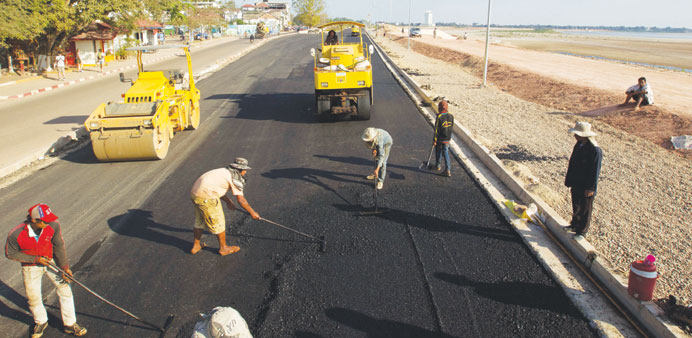Labourers carry out roadwork on the riverfront in Vientiane, Laos (file). The country’s location is favourable and its economy is closely intertwined with Thailand and China, whereby the latter is investing in railway lines and highways to improve land transport across Laos.
By Dr Arno Maierbrugger/investvine.com
After the World Bank recently released its bi-annual East Asia and Pacific Update on economies in the region, there was much talk about the diverse growth rates and the different economic standings of the more powerful and dominant nations there, but one country was overlooked by most: Laos, the small landlocked state in the heart of Southeast Asia, bordering Thailand, Vietnam, Cambodia, Myanmar and China.
The 2013 growth prediction for Laos by the World Bank is no less than 8%, which is the highest forecast in the region and also one of the highest in the world at the time. And it is not a one-time phenomenon: Growth in Laos was 8% in 2011 and 8.2% in 2012. According to the predictions published in the report, the percentage growth will slightly fall to 7.7% in 2014 but recover strongly to 8.1% in 2015.
Does this make Laos a success story and worth for Gulf investors to look at the country?
Yes and no. On the one hand, the strong growth of Laos is rooted in the country’s low level of development, meaning it has a lot to catch up and currently does so. Laos is now on par with Cambodia in development terms, but less advanced than Vietnam. Pros are that the country has attractive hydropower, mining, forestry, agricultural and tourism resources, but, on the other hand, a small and poorly skilled workforce, so it is hardly going to become a manufacturing centre similar to some of its neighbours.
But while Laos is still a communist country, foreign investment rules have been streamlined and liberalised, and foreign investors can own 100% of an approved business. The country’s location is favourable and its economy is closely intertwined with Thailand and China, whereby the latter is investing in railway lines and highways to improve land transport across Laos.
Overall, Laos is currently not a destination for large-scale investment, but still worth a look, especially in the sectors of hydropower generation and distribution, agri-business and food processing, tourism, real estate and infrastructure. For example, property prices in the Lao capital of Vientiane rose up to 15% in 2012 and further 20% so far in 2013. The Mekong River bank is one of Vientiane’s prime areas, where land is currently being sold for $3,000 per square meter, up from $2,000 per square meter in 2011.
The attraction of Laos as an investment destination is not that a huge amount of money can be made there in a short time span, but the combination of its whopping growth rate, its vastly untapped resources, the beginning privatisation of state-owned enterprises by sharing production in new investment with domestic and foreign private investors, as well as the open-door policy for investors supported by a reformist government. Actually, these are enough reasons to give it a try.
Inside Investors has just published its brand-new investment report Inside Asean 2013-14, which sheds light on investment opportunities in the ten-member bloc of Asean. The report includes a large number of analyses, interviews, background information, facts and figures and practical tips how to succeed as investor in Asean and what to avoid. The report is available under http://store.insideinvestor.com.
Our columnist Dr Arno Maierbrugger is Editor-in-Chief of www.investvine.com, a news portal owned by Inside Investor focusing on Southeast Asian economic topics as well as trade and investment relations between Asean and the GCC. The views expressed are his own.

